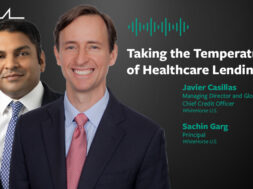Another Busy Year for Health Care
Health care remains an active sector for middle-market leveraged finance, with interest spread across a broad spectrum of subsectors.

This article is sponsored by Twin Brook Capital Partners.
This story originally appeared in the March/April 2020 print edition of Middle Market Growth magazine. Read the full issue in the archive.
Health care remains an active sector for middle-market leveraged finance, with interest spread across a broad spectrum of subsectors. Overall, health care is viewed as less cyclical than many industries because of positive demographic trends and non-discretionary types of services. Those characteristics have contributed to increased demand for deals in the space as we get further into the economic cycle.
Although the sector is broadly expected to outperform most others during a recession, investing in health care is very complex. There is no shortage of trends and risks that an investor must navigate in order to make good investment decisions. Health care is constantly in the news, with headlines focused on topics like excessive drug pricing, the opioid crisis, surprise billing, nurse shortages, Medicare for All, big data, artificial intelligence and efforts to repeal and replace the Affordable Care Act—just to name a few. However, the divided U.S. government is generally viewed as a safeguard for health care investors, given its inability to push through major legislative changes.
It appears 2020 will be another busy year for health care investing, creating robust opportunities for direct lenders. One subsector that has remained active for many years has been physician practice management, which includes specialty areas such as ophthalmology, dermatology, dental, orthopedic, gastroenterology, urology and podiatry. Managing a practice has become increasingly difficult for physicians to do on their own, and we expect this phenomenon to continue to drive attractive physician practice management deal flow in 2020 and beyond.
Other active health care subsectors include revenue cycle management, contract research organizations, medical device manufacturing, health care IT, payor services and clinician staffing. Due to relatively high valuation multiples, private equity sponsors may also look to exit investments earlier than planned, generating significant deal flow in secondary exits.
The healthy investment environment is expected to spur further competition among experienced health care lenders and draw new entrants to the space. When it comes to transaction execution, these new entrants can create additional risk by quoting high leverage levels without understanding key diligence concerns, such as the reimbursement and regulatory outlook, compliance risks, human capital issues and state-specific structuring requirements.
The complex nature of health care investing makes it important for private equity firms to partner with a lender that has deep health care expertise and a strong track record. This will make the process of closing a transaction smoother and is equally important when working through issues that may arise at a portfolio company post-close.
We expect to see more health care developments this year—especially as the presidential election kicks into high gear. Navigating the headlines as well as reimbursement and regulatory trends is par for the course for a seasoned health care investor, but it may prove difficult for new entrants.
Regardless of noise in the news cycle, we expect private equity activity in the health care space to continue, creating a robust set of attractive opportunities for lenders to deploy capital.

Tim Wentink is a managing director at Twin Brook Capital Partners, where he focuses on the origination, evaluation, structuring and negotiation of new health care lending opportunities with private equity sponsors.


